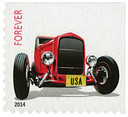U.S. #4909
2014 49¢ Front of 1932 Ford “Deuce” Roadster
Hot Rods
Ford Installs Moving Assembly Line
On December 1, 1913, Henry Ford introduced his moving assembly line, which revolutionized both his own business and the future of mass production around the world.
Henry Ford began his first car making business, the Detroit Automobil... more
U.S. #4909
2014 49¢ Front of 1932 Ford “Deuce” Roadster
Hot Rods
Ford Installs Moving Assembly Line
On December 1, 1913, Henry Ford introduced his moving assembly line, which revolutionized both his own business and the future of mass production around the world.
Henry Ford began his first car making business, the Detroit Automobile Company, in 1899. After two years, it was reorganized as the Henry Ford Company. After disagreements with his partners, Ford left the company. When he found more investors, the Ford Motor Company was established in June 1903. It began making a profit by October. Within two years, the investors had made a profit of almost 300 percent.
In 1908, Ford introduced the Model T. It was built at a larger factory. Ford’s goal was to produce a car that was so affordable, just about everyone could have one. To accomplish this, he had to decrease the cost and time it took to build his cars. Over the years, he introduced a number of improvements toward this goal. He first split the assembly of the Model T into 84 separate steps and trained each worker to do just one. Ford also built machines that could stamp out the parts faster than human workers were able to. By 1910, demand was so great that Ford moved to the larger Highland Park plant.
Then Ford had a major breakthrough. He’d seen various moving assembly lines at work in flour mills, breweries, canneries, bakeries, and meat-packing plants and believed the same concept could be applied to his factory. Ford experimented with the idea, installing moving lines for some parts of the process. Motors and transmissions were built along rope-and-pulley-powered conveyor belts. When this helped to drastically cut down the production time, Ford decided to expand its use.
On December 1, 1913, Ford put the moving-chassis assembly line to work. By February, parts were moved past workers on a motorized belt system, allowing the employees to work faster than ever. The 12-and-a-half-hour process of building the Model T was cut down to just one hour and 33 minutes. Ford’s factory produced over 200,000 Model Ts that year, and exceeded one million by 1920. Though Ford didn’t invent the assembly line, he popularized it and soon other car makers and members of other industries began adopting it.
While Ford Motor Company was successful at selling cars, it didn’t fair as well at keeping employees. The turnover rate was high, and the cost of training new workers cut into profits. In January 1914, Ford took a risk and doubled the pay to $5 a day. He also shortened the shifts to eight hours from nine and reduced the work week to five days. Workers stayed at their higher-paying jobs and production increased.
The Ford company went on to support both World War I and II, producing trucks, tanks, jeeps, airplanes, and thousands of parts, all made quickly and affordably thanks to Ford’s innovative adaptation of the moving assembly line.
This stamp is one of two issued at the National Street Rod Association’s “Street Rod Nationals East Plus.” It pictures the front of a 1932 Ford Deuce roadster.
Hot rods were born in Southern California’s dry lakebeds during the late 1920s. Located a few hours from Los Angeles, these open areas were free of obstructions, making them ideal for racing. Teens flocked to race at spots like El Mirage, where speeds sometimes reached 100 miles per hour. Those who couldn’t make the trip simply raced on the streets of Los Angeles, defying both their parents and the police.
Ford Models A and T were preferred at first because they were inexpensive and lightweight. Unnecessary equipment was stripped, the bodies were lowered, special mufflers were used to create a “burble” sound, and custom headlights were added. Much of the work was done by amateur mechanics, but competition to go faster and look cooler gave rise to an industry devoted to creating highly customized cars.
The ”˜50s were the golden age of hot rods. Cruising from one drive-in to another was a way for teens to showcase their cars and find a competitor to drag race. The National Hot Rod Association helped move the sport into mainstream by promoting safety. The NHRA took the lead, moving racing from the streets and establishing classes where vehicles competed based on weight, body style, engine displacement, and cylinders. Today, thousands of fans flock to NHRA races, where hot rods can exceed speeds of 300 miles per hour.
The Hot Rods stamps were digitally created by John Mattos. His art appeared on a U.S. stamp for the first time in 2006 (#3995 – Winter Olympics). Mattos, a graphic artist, is known for his art deco style.
49¢ Hot Rods, issued to satisfy the first-class mail rate
Issue Date: June 6, 2014
City: York, PA, at the National Street Rod Association’s “Street Rod Nationals East Plus.”
Quantity: 50,000,000
Category: Definitive
Printed By: CCL Label Inc.
Printing Method: Photogravure
Perforations: Serpentine Die Cut 11 ¾ X 11 ¼
Self-adhesive
Less 












